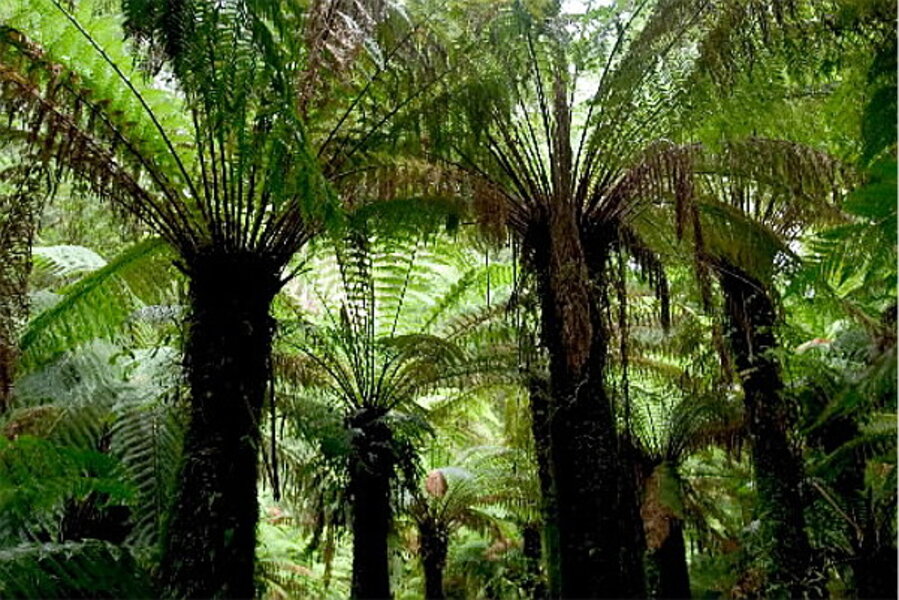Surprise! Old growth trees are 'star players' in gobbling greenhouse gas.
Loading...
The oldest trees in a forest aren't just passively clinging to the carbon they've drawn from the atmosphere and stored as leaves and wood – they're capturing CO2 at a pace that increases with each passing year.
That's the surprising result from an exhaustive new study of tree growth and carbon storage, a key element in Earth's carbon cycle and a focus of international efforts to draw up a new international climate treaty.
For years, conventional wisdom held that even if old-growth trees weren't felled by fire, disease, lightning, or chain saws, they retained no additional carbon as they entered their golden years. They were valuable as storage bins for the carbon they had taken up and stored as they grew. But few counted on old-growth trees to continue sequestering CO2 from the atmosphere in their senior years.
That bit of arboreal ageism began to change in 2008, when researchers published a study showing that old-growth forests actively added to their carbon stocks, although at a slower pace than forests with younger demographics.
Now, an international research team has shown that, for many tree species across the globe, old trees accumulate carbon at an increasing rate as time passes. On average, trees whose trunks are about three feet across add nearly 230 pounds of dry mass to their girth each year. That's about three times more mass than a younger tree of the same species with a trunk half as wide would add.
This does not mean that trees will save the planet from the relentless rise of heat-trapping CO2 in the atmosphere resulting from human industrial activities and land-use changes, researchers caution.
The fact that concentrations continue to rise in itself shows that natural sinks for carbon aren't keeping up with human emissions, although they are moderating the increase the atmosphere sees.
Nor do the results imply that old-growth forests are better at soaking up and retaining CO2 on a given day than large stands of young trees or forests with a broader mix of young and old, says Nathan Stephenson, a forest ecologist with the US Geological Survey's Western Ecological Research Center in Three Rivers, Calif. Mortality rates in these younger forests tend to be lower, allowing more trees to carry on the vital work of photosynthesis. And proportionately fewer trees are dying at any one time, limiting the net amount of carbon dioxide that returns to the atmosphere as the dead trees decompose.
Still, in managing forests for the carbon they actively acquire and hold in long-term storage, "you need to know who your star players are on the team. It turns out that the star players in an old forest are the old trees, not the young trees."
The results are "very exciting," says Doug Boucher, director of tropical forest and climate initiative at the Union of Concerned Scientists, an environmental group based in Cambridge, Mass. "It reinforces the value of old-growth forests for the storage of carbon in the biosphere."
Beyond a tendency to anthropomorphize the life cycle of trees, doubts about the capacity of older trees to increase their carbon stores had some basis in earlier research, Dr. Stephenson says.
Researchers looking at the role of leaves noted that as trees grew older, their leaves became less efficient at taking up CO2 – which would be expected to show up as a slowdown in carbon accumulation. And in stands where the trees were all about the same age, net CO2 storage declined as the trees aged.
A couple of studies, each focusing on an individual species, found that the older trees in their samples bucked conventional wisdom. But the results weren't overwhelming enough to overturn it.
Stephenson and his colleagues culled their measurements from records kept at research stations worldwide. Their sample included more than 670,000 trees, representing 403 species from six continents. Their measurements focused on increases in trunk diameter at a standard height above the ground.
Overall, 98.6 percent of the species in the sample experienced increased mass with age, suggesting that while a tree might reach a maximum height, it could add mass along its trunk indefinitely, with biggest trees adding the most mass.
One reason, Stephenson explains, is that as trees grow, they continue to add branches and leaves. Even though the carbon uptake of an individual leaf might decline with time, an older tree has many more leaves than its younger siblings. A decline in leaf efficiency is more than offset by an increase in numbers.
As for the sequestration declines seen in old stands of trees of similar age, such stands started out with many more trees, which would have boosted their carbon-sequestration potential. "You can pack a lot more young trees on a patch of land than old trees," Stephenson says.
The study's results have important implications for managing forests in a warming climate, he adds.
In regions such as the US's Mountain West, climate-related contributions to wildfire frequency and intensity, as well as to more-frequent infestations of insects such as the Mountain pine beetle, already are putting more-intense stress on forests.
"Maybe if environmental changes are hitting your biggest trees the hardest, this is sort of an added impetus to go: 'Oh my gosh, we need to mitigate that,' because these are the star players in pulling carbon dioxide out of the atmosphere," he says.








